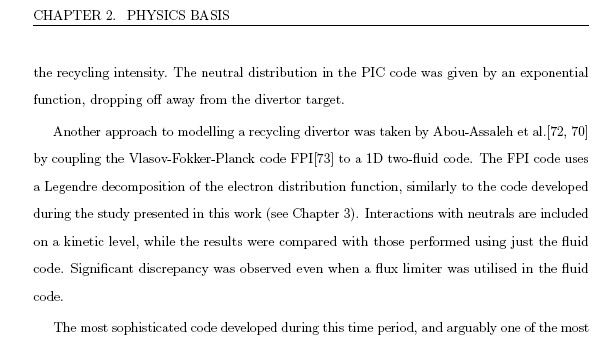|
|
|
Citations Index
>>> |
|
Articles With Citations
to Z. Abou-Assaleh
|
|
Theoretical Plasma
Physics |
|
Controlled Thermonuclear Fusion Energy |
| |
|
2022 |
|
|
|
|
|
2022
No 02 |
|
|
|
|
|
|
|
Modelling of Kinetic E ects in
Parallel Transport
in the Tokamak Scrape-O Layer
Stefan Mijin
Submitted in part ful lment of the requirements
for the degree of Doctor of Philosophy in Physics at
Imperial College London.
Department of Physics
The Blackett Laboratory
Imperial College London
SW7 2AZ
https://spiral.imperial.ac.uk/handle/10044/1/83170
....

...
Bibliography
...
[70]
Z. Abou-Assaleh, M. Petravic, R. Vesey, J. P. Matte, and T.
W. Johnston, \Non-Local
Transport in a Tokamak Plasma Divertor with
Recycling," Contributions to Plasma
Physics ,
vol. 34, no. 2-3, pp. 175{179, 1994.
[71] R. J. Procassini and D. A. Knoll,
\Kinetically motivated boundary conditions for uid
models of scrape-o
layer transport," Journal of Nuclear Materials ,
vol. 196-198, no. C,
pp. 363{368, 1992.
[72]
Z. Abou-Assaleh, J. P. Matte, T. W. Johnston, and R.
Marchand, \Fokker-Planck
Modelling of Edge Plasma Near the Neutralizer
Plate in a Tokamak," Contributions to
Plasma Physics , vol. 32,
no. 3/4, pp. 268{272, 1992.
[73]
J. P. Matte and J. Virmont, \Electron heat transport in a
steep temperature gradient,"
Physical Review Letters , vol. 49, no.
26, pp. 1936{1939, 1982.
...
|
|
|
Title: Modelling of kinetic effects in parallel transport in
the tokamak scrape-off layer
|
Authors: Mijin, Stefan
|
Item Type: Ph.D. Thesis or dissertation
|
Abstract:
|
Heat flow onto divertor targets in the tokamak represents
one of the main design problems in current fusion research. Excessive heat
loads, especially during violent transient events, can significantly damage
the plasma-facing components. In order to mitigate the heat load it is
beneficial to run the tokamak in a detached regime. This involves formation of
a neutral cloud in front of the divertor targets that protects the surface
material. Thus interaction of the plasma with the detached neutrals becomes
important.Energy, on its way to the divertor targets, travels through the
boundary region of the tokamak, the Scrape-Off Layer. The main transport
direction is parallel to the open magnetic field lines of the Scrape-Off
Layer. Fluid models are routinely used to simulate particle and energy
transport in the boundary region, but these fail to capture kinetic effects,
which have been linked to discrepancies between said fluid model predictions
and experimental data[1]. Kinetic/non-local effects have been observed in
simulations of parallel transport, including heat flux suppression and
enhancement[2], as well as effects on ionisation rates[3]. The plasma sheath
at the divertor target is also affected by non-local phenomena[4,5]. Exploring
how kinetic effects change facets of parallel transport, and especially how
they cause departure from widely used fluid models, is important in furthering
our understanding of heat load issues, which are critical to future machine
design.In this thesis, a novel framework for studying electron kinetic effects
in parallel transport is developed, with special focus on the proper treatment
of the sheath boundary condition and inelastic collisions, and the capability
of self-consistent comparison between a kinetic and fluid model. This
framework is implemented in the new electron kinetic code SOL-KiT, and details
on the model and numerics, as well as benchmarking, are presented.With the
developed code, a systematic power scan study of non-local effects in both
equilibria and transients has been conducted. Kinetic effects are found to be
especially prominent in the interaction of transients with detachment, where
heating due to fast particles, heat flux suppression, as well as modification
of ionisation rates have been observed.
|
https://spiral.imperial.ac.uk/handle/10044/1/83170
|
|
|
|
|
|
2022
No 01 |
|
|
|
|
|
|
Measurement of Mach probe on
plasma flow velocity in highly collisional plasma jetIn Je Kang*,
Hyonu Chang, Yong-Sup Choi, Soo Ouk Jang, Chang Hyun Cho, Ji
Hun Kim, Hyun Jae Park
Institute of Plasma Technology,
Korea Institute of Fusion Energy, Gunsan, 54004, South Korea
Current Applied Physics >>>
Abstract
A normalized plasma flow velocity
in highly collisional plasma formed by a microwave plasma jet,
which is dimensionless unit for plasma flow velocity/ion acoustic
velocity, was measured by the parallel Mach probe. To deduce the
normalized plasma flow velocity under highly collisional plasma
conditions, the collisional model of a Mach probe was proposed. In
addition, neutral gas flow velocity which assumed to be plasma
flow velocity was calculated by the turbulent model. The results
for the two different models were compared with those for the
collsionless models of the Mach probe. The turbulent model
produced 2–4 times reduced values than by measurements with
collsionless models. The measured results with the collisional
model were shown as approximately 100–250% lower than those for
collsionless models. They were obtained to be in good agreement
with difference rate of 10–30% when compared to those for the
turbulent model.
Reference
....
[4] S.L. Gulick, B.L.
Stansfield, Z.
Abou-Assaleh, C. Boucher, J.P. Matte, T.W. Johnston, R.
Marchand, Measurement of pre-sheath flow velocities by
laser-induced fluorescence, J. Nucl. Mater. 176 (1990) 1059,
https://doi.org/10.1016/0022- 3115(90)90192-P.
....
|
|
|
|
|
Citations Index
>>> |
|
